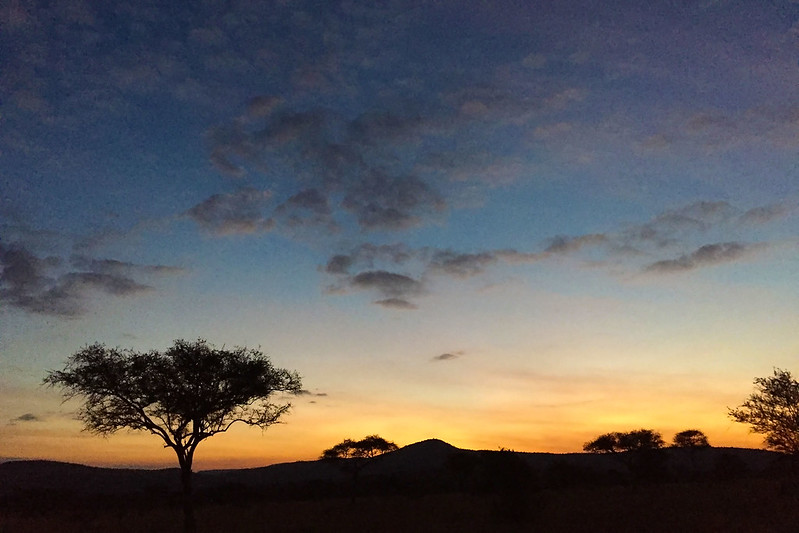
Sunrise at Nimali Camp
[ <<previous | index | next >> ]
16:41. Lemala Camp, Ngorongoro Crater Rim
This morning we asked the question about what the staff do if a dangerous animal appears. M. thought they might wave a torch at it, because the animals would be afraid of the light. But when we asked, they said that you shouldn't shine light at them because it provokes them. The thing to do is just back away slowly. We had visions of Lex in Jurassic Park waving a light at the T. rex and Alan Grant willing her not to. They also said that there were lions around the camp during the night and described the sound they made, a sort of extended grunting, which was the sound we'd heard but had assumed was zebras or something.
Our alarm got us up at 06:00. After dressing we emerged into the pre-dawn light, still a bit dark a few minutes earlier than we'd been the last two mornings. A staff member came to meet us with a torch and escorted us to the dining tent, answering the questions about animals in the night.
 Sunrise at Nimali Camp |
For breakfast I had the same as yesterday, the muesli and eggs benedict, while M. just had muesli and toast, although we both tried some of the pastry of the day, which was carrot bread today, with a delicious nutty top on the loaf.
After breakfast we packed our bags, double checked the room, and checked out by handing in the key and writing a message in the guest book. Timba was waiting by the car as we walked out, just a couple of minutes late. The morning wasn't as cold as yesterday, and we drove with the safari roof down, as we were making time to our next destination, on the Ngorongoro crater rim.
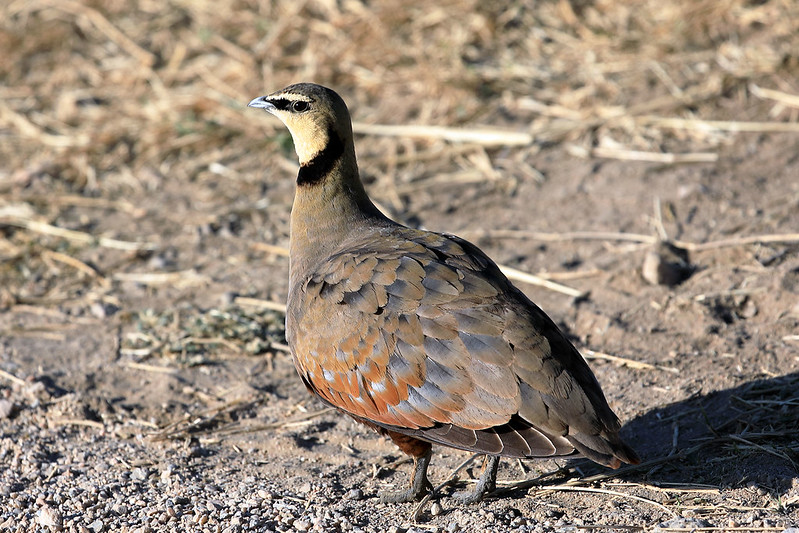 Yellow-throated sandgrouse |
We didn't stop for many animal sightings, but Timba did stop to point out a couple of birds we hadn't seen before. The drive retraced our route from when we drove into Serengeti, back through the Naabi Hill entrance gate. Just before we got to the gate, we saw a giraffe with a small baby.
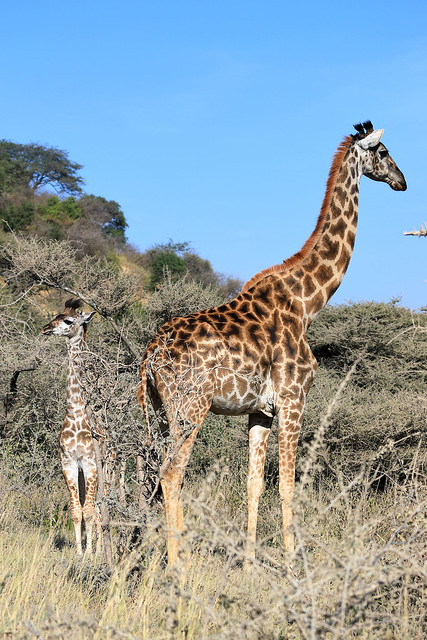 Giraffe with baby, Naabi Hill |
As we moved on, and turned the corner in the road, we discovered that the giraffes were just maybe 100 metres or so from the entrance gate, and crowds of people ooh-ing and aah-ing over lizards and birds, not realising there were giraffes just around the corner. We had to stop at the gate again for Timba to deal with paperwork once again. While he did that we used the toilets and then walked around trying to get photos of some of the birds we hadn't yet become familiar with. I got a good photo of a male sunbird, with its iridescent wings and belly.
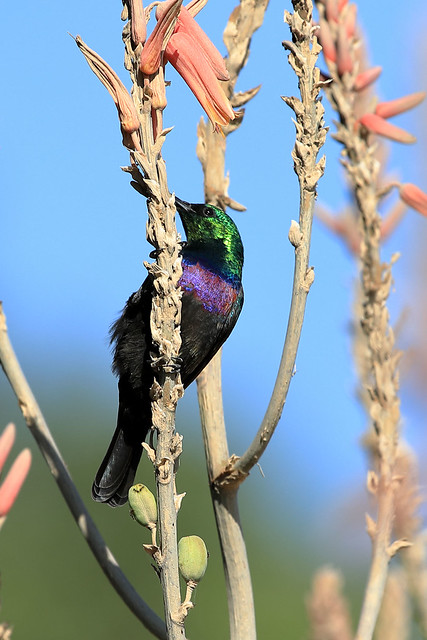 Marico sunbird, male |
Then we drove the long haul to the border of Ngorongoro Conservation Area. Somewhere along the way we turned off to head out to Olduvai Gorge, where there was a small museum. Timba said we could spend about 45 minutes looking through the exhibits and then a staff member would give us a brief talk about the gorge and the fossil discoveries there, and there was a lookout spot for seeing the gorge itself. We browsed the exhibits, which included some replica fossils and also some genuine fossils of various hominid species, stone tools, and of course an informational series of displays and signs about the evolution of humans, and also Louis and Mary Leakey's discoveries here at the gorge.
 Monkey at Olduvai Gorge |
Then we had a staff member give us a talk about the site. Firstly he said that the traditional Maasai name of the area was Oldupai, but the original German explorer Wilhelm Kattwinkel who travelled here in 1911 asked the name and then recorded it incorrectly as "Olduvai". And now the locals were mounting a campaign to change the name back, but the wrong one had become os entrenched that progress was very difficult. He said that students were active digging in the gorge right now, pointing some out in the distance. The digging season lasts from June to August, after the rainy season, and the students live in tent camps, which he pointed out on the far rim of the gorge. He explained the various layers of geological strata visible in the gorge in front of us. From the bottom we could say a black volcanic ash, deposited about 2 million years ago, then a white volcanic ash about 1.8 million years old, then grey ash of a younger age, then on top of that was a thick red layer which was sediment deposited by a river. This red layer had no fossils as it wasn't geologically suited for preserving them. Finally above that was another grey layer, corresponding to the plateau surface at the top of the gorge.
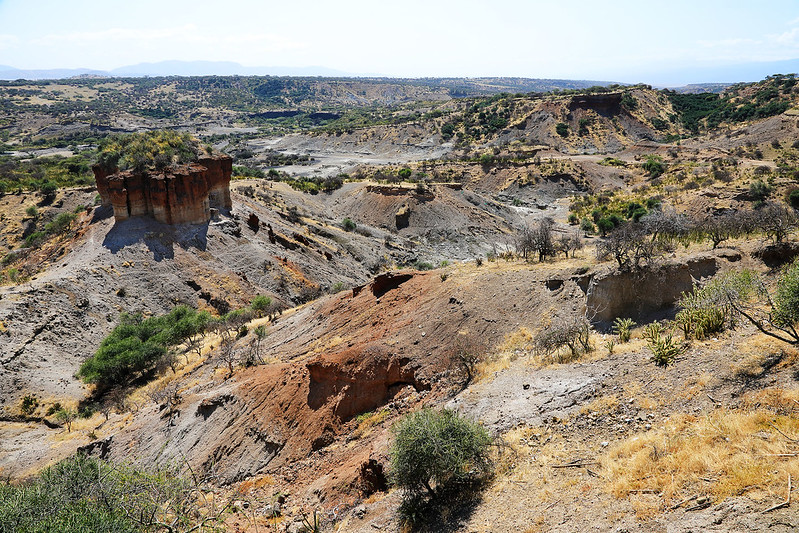 Olduvai Gorge |
We used the toilets just before we left, then continued driving on to Ngorongoro. The plains gave way to a climb into the mountains of the crater rim. I took some quick photos out the car window, and the GPS on my camera told me we were at 2300 metres, which is higher than Mount Koscuiszko. We passed the lookout spot which we had passed on the way out to Serengeti, and turned onto a new road which went around the crater anticlockwise, to the north. This led us, after nearly an hour of driving, to Lemala Camp, which is a tent camp similar to Nimali. We got a briefing on the accommodation, which here has a bucket shower. You need to inform a staff member when you want a shower and they prepare a container of hot water on the roof of your tent, which you control with pull cords inside the shower.
By now it was almost 14:00 and time for a late lunch. We sat at the long dining table, which the staff explained was for communal meals with all the camp guests, although we were the only ones here for lunch. We had bread rolls, vegetable lasagne, and a cucumber and avocado salad, which were all good.
 Eating lunch at Lemala Camp |
We wanted to do the optional visit to a Maasai village, so organised that with the staff, who got Timba to meet us at 15:00. With a few minutes to kill, I tried the bow and arrows that were sitting outside the dining tent, with a stuffed hessian bag with a target painted on it mounted on a pole. I've never really used a bow before, so my first shot fell too short. I increased the pull and aimed for my second shot, which flew slightly wide to the right. I compensated by aiming a bit to the left and managed to hit the target, about 30 centimetres above the bullseye. That was satisfying enough, and I later found I'd grazed the lower knuckle on my thumb firing the arrows.
We were told, or so we thought, that the Maasai village visit would cost us US$50 per person. Timba drove us about five minutes to the village, which was set up for tourists to visit. The son of the chief met us and took us around the village, explaining various things about how the Maasai live. The village was a small compound centred on a cattle pen. Around this were a dozen or so small huts, where the chief's wives lived, and the chief rotated amongst them. And then there was a fence of sticks surrounding the huts.
First of all, the chief's son took US$50 from us to pay for this visit, saying that was the total when I offered him twice as much. He said this allowed us to take as many photos as we wanted. This done, about twenty Maasai did a welcoming dance for us outside the fenced area. The men lined up facing us, and some women joined in, forming a line attached to the end of the line of men. They all chanted, the women and men performing different parts of the rhythm. They all swayed in time to the chant, and then single men would step forward from the line and perform a few vertical jumps in the air before returning to the line, when another man would step forward and do the same. There didn't seem to be any clear indication that I could tell which signalled which man would jump next, but they were obviously synchronised somehow. Women came over and placed beaded necklaces around our necks, and then ushered us to join the dance. They took M. over to the women's side and showed her how to do the female dance steps, while some men grabbed me and took me to the men's side. They gave me a smooth rod of wood, the same as they were all carrying, and then showed me how to hold it while jumping in the air, the stick held upright by the handle end at the bottom. I did some jumps, trying my best to emulate them, which seemed to please them all.
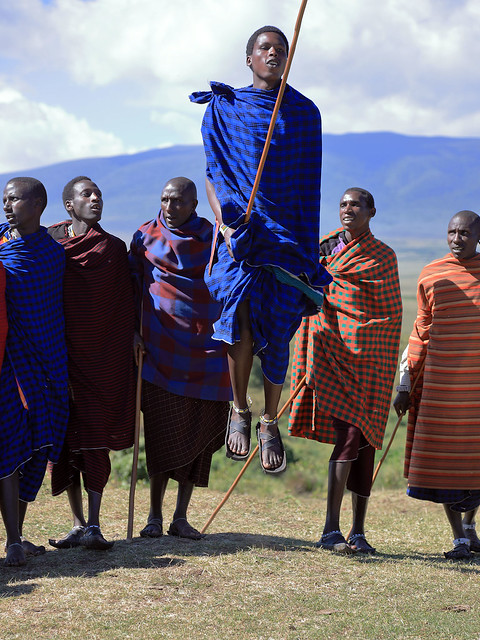 Maasai jumping dance |
After the dance, the chief's son showed us around inside the village. First he showed us how they make fire, using a cedar board with a rounded impression in it, and a stick of fig wood spun between the hands while resting in the impression. This was placed on the blade of a machete. Three men took it in turns to spin the stick in rapid succession, to build up the heat on the cedar board. Within a minute or so it was smouldering, and they raised the board, leaving a tiny pile of smoking ash on the machete blade. Then a man encircled this with a ball of tinder made of dry grass. He lifted the tinder ball and held it up in the air for the breeze to blow through it, adding some breath from his mouth. More smoke rose from the ball, and then suddenly it burst into flame. He dropped it on the ground and another man laid some thin twigs across it to build the fire. It was amazing how fast they produced a fire from just a few bits of wood.
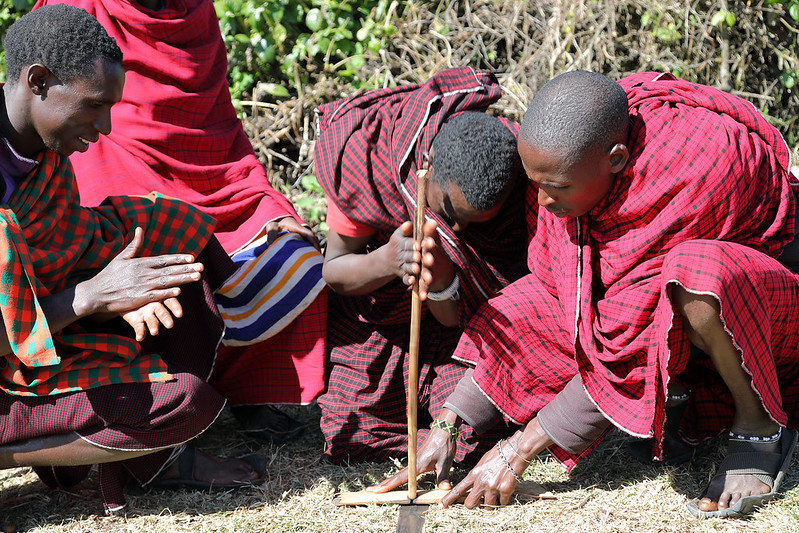 Making fire |
This impressive display over, the chief's son took us inside one of the huts. We had to bend over as the roof was low, and we squeezed past a baffle that separated the door from the interior, keeping out the bright light of day. Inside it was very dark, with only three tiny windows, holes in the thick wall only four or five centimetres across. There were three tiny rooms: a kitchen just large enough for one or two people to sit around the tiny fireplace, and two bedrooms which were floored with cowhide for sleeping on and barely big enough for one or two people to sleep in. The roof was wooden poles covered in thatch, and the walls were straw and mud plastered with cow dung, though there was no smell at all apart from a strong smokiness from the fireplace.
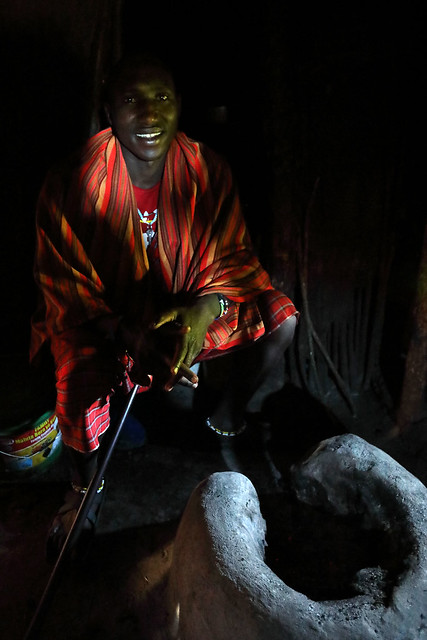 Chief's son inside the hut |
Next we did a circuit of the cow pen, where women had set up displays of handcrafts, from which we could select and buy items. I chose a talking stick, a baton wielded by the chief as a symbol of authority, which could be leant to others when they were to speak and others would pay attention to them. It was made of wood and covered in beads. The first one I picked up was in the colours of the Tanzanian flag, but I asked if there was a more traditional colour scheme, and the chief's son said multicoloured, so I chose one like that, with gold bands between sections of multicoloured beads. M. grabbed a few things too, including a bracelet made of soft iron, which a woman unwound and rewrapped around her wrist for a custom fit. The chief's son added up the costs and announced the total was US$143. I could see M.'s jaw drop, and she quickly said we couldn't afford that and asked how much for just the talking stick. This was US$50, which was the extra we thought we'd have to pay for the visit so we were prepared to spend this much, but the rest was too much and we decided not to get it, despite the son trying to bargain us down substantially.
With the talking stick bought, he led us to the village kindergarten, a brick building about 50 metres behind the village. A dozen or so children greeted us and demonstrated their knowledge of counting in three languages, a traditional Maasai language, Swahili, and English, as well as the alphabet. They sang us a song, and then the chief's son explained that this kindergarten was for children 5 or 6 years old, after which they would travel a few kilometres to attend a primary school. Children from other nearby villages also travelled here to attend this kindergarten. He suggested we could leave a donation with one of the two men who served as teachers, and I gave them 20,000 shillings.
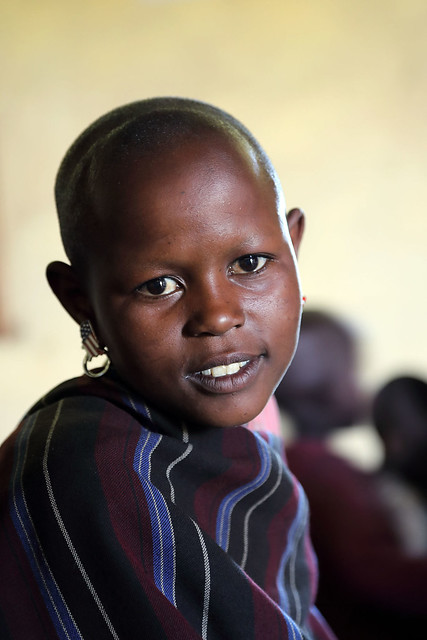 Maasai schoolgirl |
As we left, I asked how many cows the village had, and the son said instantly, "fifty one". I realised there were a lot more men and women around than could be accounted for by the huts for the chief's wives and asked where they lived. He said they lived in other villages nearby, but came here to assist with the cultural demonstrations for tourists and to sell their craftwork. The visit done, we returned to Lemala.
It was nearly 16:30 and M. asked for her bucket shower to be ready for then, and for mine to be ready at 17:30, so we could both be done before dinner, rather than after when it would be colder. At 16:30 we heard sounds of water being filled above the canvas bathroom roof, and then Major, our room assistance, called out through the canvas wall, "Your shower is ready!" M. pulled one of the chains on the shower head and a trickle of water rained down. It was warm and she had a quick shower, saying it was fine.
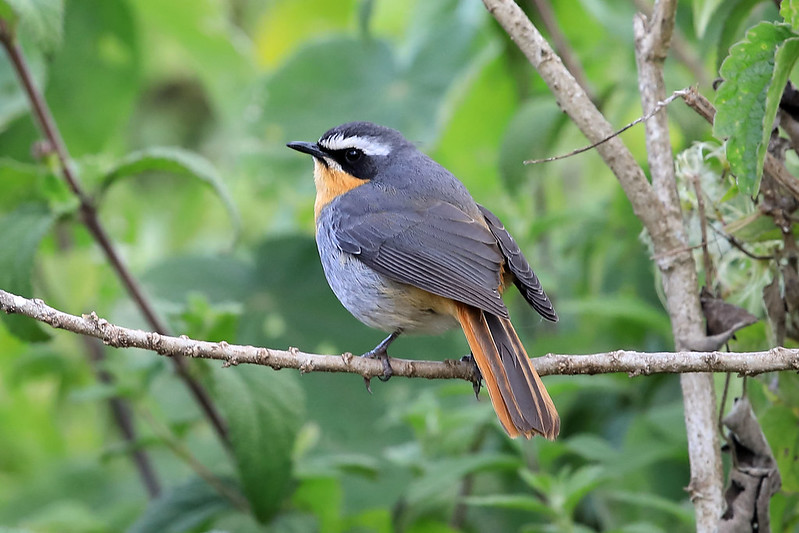 Cape robin-chat at Lemala Camp |
After this, I had some time to spare before my own shower, so walked around outside the tents looking for birds to photograph. I shot a few, then Nelson, the camp manager, came out and asked if I was looking for birds. When I said yes, he offered to take me around and help find some. He spotted two different birds that I wouldn't have even seen in the surrounding vegetation, and then he said there was a chameleon behind the toilet tent, and took me there to see it. It was partly hidden by foliage, but an assistant used a stick to move it and I got some nice shots of this amazing multicoloured lizard.
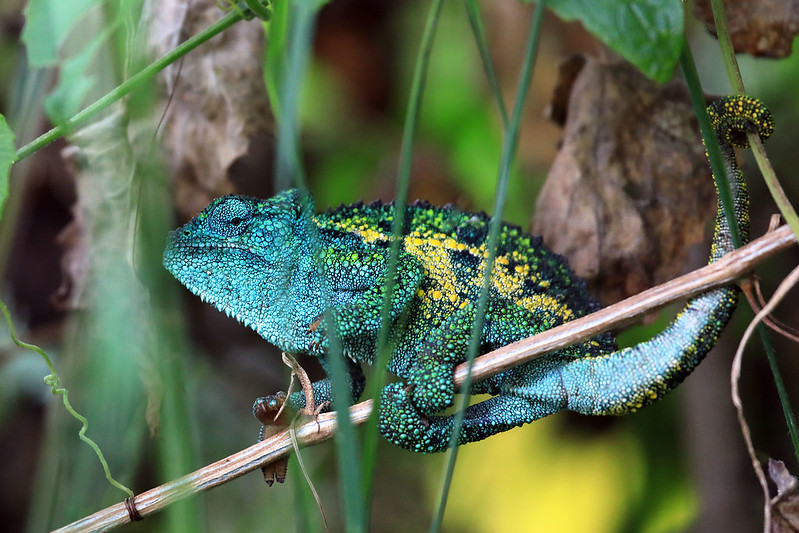 Chameleon at Lemala Camp |
At 17:30 I had my shower. I experimented with the chain pull and discovered that pulling the other chain hard made the water run in a much fuller shower spray than M. had ever produced! I lathered and rinsed fairly quickly, then redressed for dinner. We went to the lounge and met a family from Berkeley in California, and I told them I was in Berkeley just three weeks ago! As we were sitting, a large group of Australians arrived at the camp, and we later discovered they are from Sydney too. Then more people arrived, a French couple from Lyon, and four people from Belgium, as we all introduced ourselves throughout the evening.
M. had a glass of red wine while I had a gin and soda in the lounge, as the Americans played Yahtzee. They then moved to the seats outside around the bonfire as the sun began to set. The father of the family started looking through some photos he'd downloaded into a tablet computer and I had a look at some. He'd got some great shots of hippos with their mouths wide open. We lingered inside a bit more until the sunlight had died away and then joined them outside. The other groups then joined us too after they had looked around their own tents. Staff brought out snacks of cassava chips and tortilla chips with chilli sauce or guacamole, which were really good. Everyone was chatting, sharing stories of what we've seen so far on our trips and our plans after leaving here.
A bit after 19:00 the staff called us all in for dinner. We sat together at the one long table, continuing our fireside chats as we ate. Dinner was butternut pumpkin soup (as we had last night!), then pork chops with potato dauphinoise and ratatouille, with M.'s substituting snow peas for the chop. Dessert they announced would be a surprise. It turned out to be a cake with chocolate icing, presented to the French lady as a birthday surprise, given this trip was a birthday present for her, even though her birthday was exactly six months ago!
 Pork chop and veges |
During dinner conversation we learnt that at least two of our fellow travelling groups had apparently been advised by their travel agents that they should bring gifts or donations for rural school children that they might visit during their trips. One woman said she brought a large bag filled with exercise books, pens, pencils, sharpeners, etc. When she gave them to the children at a school she visited, the teachers were delighted. Another woman said that she decided to bring soccer balls, transported deflated and squished down, plus a pump. The kids she gave these to were delighted, and the teachers were very excited to get a ball pump. This was the first we'd heard of anything about bringing items for children. It's a good idea and it would have been nice to do something like this rather than simply donating cash, although I'm sure that's useful too.
After dinner we returned to our tent, where the gas heater was on, so it was nice and warm, although this didn't extend to the bathroom area beyond the tent flap. We also found hot water bottles in the bed, wrapped in fleecy envelopes. Major was hanging around and told us they'd turn the heater off from outside the tent, so it wouldn't be on while we were sleeping. We undressed for bed and hopped in where it was nice and warm.
[ <<previous | index | next >> ]